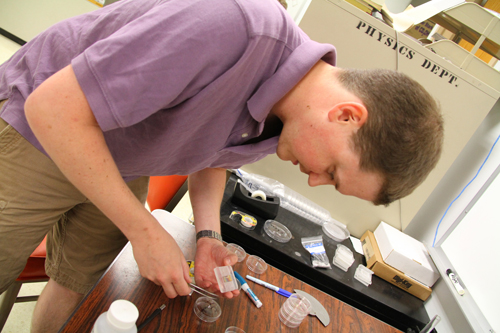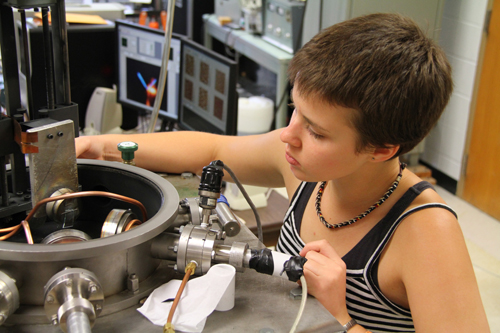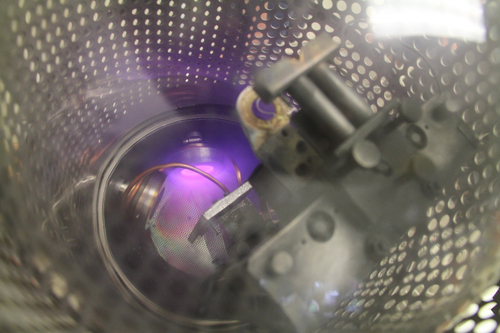Posted 3:40 p.m. Thursday, June 28, 2012

 [/caption]One UW-La Crosse professor’s research could help this country better harness the power of the sun.
UW-L Assistant Professor of Physics Seth King’s research aims to find materials to make the solar cells more affordable. Solar cells convert sunlight into electricity whether small cells used to charge watch batteries or larger systems that power homes.
His work comes at a time when solar power is becoming increasingly popular. In the first quarter of 2012, solar installations in the U.S. increased 85 percent from the first quarter of 2011, according to the Solar Energy Industries Association.
[caption id="attachment_13052" align="alignright" width="500" caption="Loralee Bilke, a former UW-L physics student, is aligning a substrate (the platform or base onto which the materials are deposited) in the machine with the vacuum chamber. The machine helps UW-L researchers create new oxide materials to be analyzed. "]
[/caption]One UW-La Crosse professor’s research could help this country better harness the power of the sun.
UW-L Assistant Professor of Physics Seth King’s research aims to find materials to make the solar cells more affordable. Solar cells convert sunlight into electricity whether small cells used to charge watch batteries or larger systems that power homes.
His work comes at a time when solar power is becoming increasingly popular. In the first quarter of 2012, solar installations in the U.S. increased 85 percent from the first quarter of 2011, according to the Solar Energy Industries Association.
[caption id="attachment_13052" align="alignright" width="500" caption="Loralee Bilke, a former UW-L physics student, is aligning a substrate (the platform or base onto which the materials are deposited) in the machine with the vacuum chamber. The machine helps UW-L researchers create new oxide materials to be analyzed. "] [/caption]Although the price of solar power is declining, it has always been expensive.
A 100-watt solar panel might cost a couple hundred dollars or more and generates about enough energy to power a standard light bulb.
So, what makes solar panels so expensive? King says it’s the transparent outer-layer of the solar cell called the Transparent Conducting Oxide. It is typically comprised of indium tin oxide and indium is nearly as expensive as silver.
King notes, when looking for an alternative, not any material will do. The layer has to be able to filter sunlight and carry converted energy from a deeper layer of the cell. He and fellow student researchers are trying to find new oxide materials that [caption id="attachment_13055" align="alignright" width="500" caption="The machine in action. "]
[/caption]Although the price of solar power is declining, it has always been expensive.
A 100-watt solar panel might cost a couple hundred dollars or more and generates about enough energy to power a standard light bulb.
So, what makes solar panels so expensive? King says it’s the transparent outer-layer of the solar cell called the Transparent Conducting Oxide. It is typically comprised of indium tin oxide and indium is nearly as expensive as silver.
King notes, when looking for an alternative, not any material will do. The layer has to be able to filter sunlight and carry converted energy from a deeper layer of the cell. He and fellow student researchers are trying to find new oxide materials that [caption id="attachment_13055" align="alignright" width="500" caption="The machine in action. "] [/caption]could work on this outer layer that are transparent, good conductors and don’t cost as much to manufacture as the oxides currently used.
“I love this research,” says Loralee Bilke, a former UW-L student who assisted King the lab. “I’m really into alternative energies and when I tell people this is what I did for a couple of summers, they are really impressed.”
In the lab, students monitor a machine with a vacuum chamber that slams atoms into metals such as zinc, copper and magnesium. The collisions release the metals so that they can bond with oxygen and form different kinds of oxide materials. So far they’ve created and analyzed numerous materials to determine if these oxides have the characteristics necessary to be part of the outer layer of the solar cell.
Bilke says the lab gave her a crash course in using power tools and other lab equipment, including the machine with the vacuum chamber.
“When I first looked at the lab, it was pretty intimidating,” says Bilke, noting all the dials and buttons reminded her of the interior of a spacecraft. “But I learned how to use most of that equipment. It was really nice to get that experience and know what the lab setting and conducting research is like.”
It’s something she hopes to use as she completes a degree in Aerospace Engineering at the University of Minnesota and eventually plans to apply for a career at Boeing.
In addition to helping students get closer to future careers, King says they are getting closer to finding the right material to make the more affordable solar cell. He gave a presentation this spring at an American Physical Society meeting about a layered material made out of zinc and copper oxide. The material shows great promise, he notes.
Once King and his team have found materials that will be economically viable competitors to indium-based oxides, they would like to partner with manufacturers to create solar cells, says King.
King completed his doctoral research at UW-Milwaukee on zinc and magnesium oxides. He had a choice between moving to Austria for post-graduate work, but chose to stay within the UW System.
“The La Crosse physics department has always had a strong reputation,” says King. “I knew I could do excellent research here and also teach, which I enjoy.”
[/caption]could work on this outer layer that are transparent, good conductors and don’t cost as much to manufacture as the oxides currently used.
“I love this research,” says Loralee Bilke, a former UW-L student who assisted King the lab. “I’m really into alternative energies and when I tell people this is what I did for a couple of summers, they are really impressed.”
In the lab, students monitor a machine with a vacuum chamber that slams atoms into metals such as zinc, copper and magnesium. The collisions release the metals so that they can bond with oxygen and form different kinds of oxide materials. So far they’ve created and analyzed numerous materials to determine if these oxides have the characteristics necessary to be part of the outer layer of the solar cell.
Bilke says the lab gave her a crash course in using power tools and other lab equipment, including the machine with the vacuum chamber.
“When I first looked at the lab, it was pretty intimidating,” says Bilke, noting all the dials and buttons reminded her of the interior of a spacecraft. “But I learned how to use most of that equipment. It was really nice to get that experience and know what the lab setting and conducting research is like.”
It’s something she hopes to use as she completes a degree in Aerospace Engineering at the University of Minnesota and eventually plans to apply for a career at Boeing.
In addition to helping students get closer to future careers, King says they are getting closer to finding the right material to make the more affordable solar cell. He gave a presentation this spring at an American Physical Society meeting about a layered material made out of zinc and copper oxide. The material shows great promise, he notes.
Once King and his team have found materials that will be economically viable competitors to indium-based oxides, they would like to partner with manufacturers to create solar cells, says King.
King completed his doctoral research at UW-Milwaukee on zinc and magnesium oxides. He had a choice between moving to Austria for post-graduate work, but chose to stay within the UW System.
“The La Crosse physics department has always had a strong reputation,” says King. “I knew I could do excellent research here and also teach, which I enjoy.”
